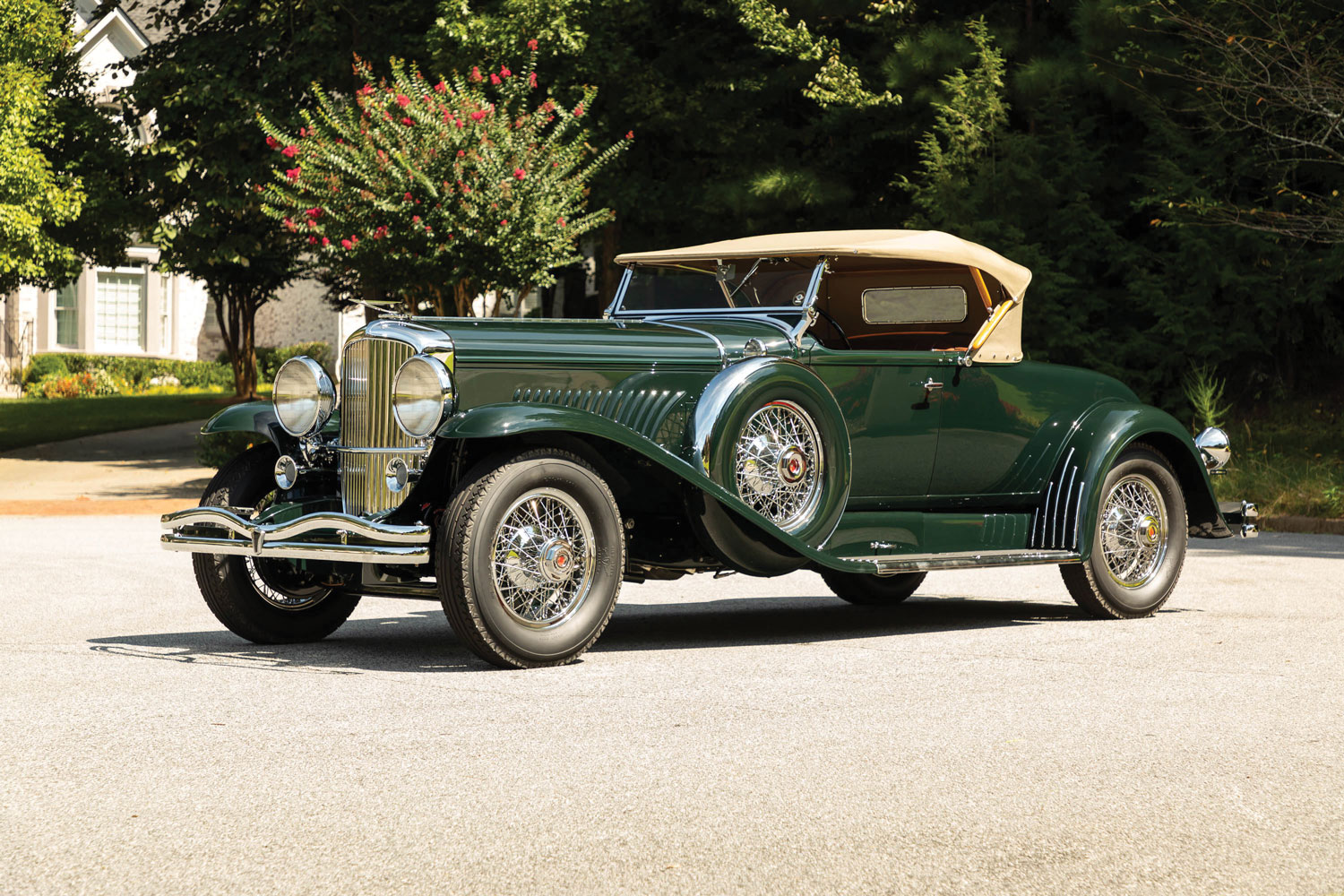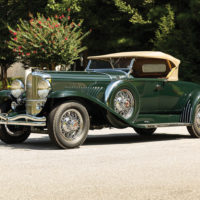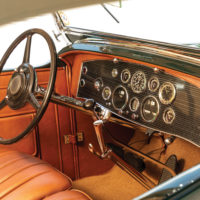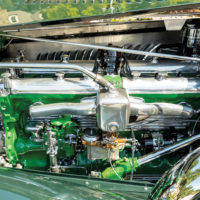SCM Analysis
Detailing
| Vehicle: | 1931 Duesenberg Model J Roadster “Green Hornet” |
| Years Produced: | 1929–37 |
| Number Produced: | 481 |
| Tune Up Cost: | $1,000 (estimated) |
| Chassis Number Location: | Stamped on the firewall, high up near the left center |
| Engine Number Location: | Left-hand engine support |
| Club Info: | Classic Car Club of America, Auburn-Cord-Duesenberg Club |
| Website: | http://www.classiccarclub.org |
| Alternatives: | 1928–30 Bentley Speed Six, 1934–40 Mercedes-Benz 500/540K, 1935–40 Horch Model 853 |
| Investment Grade: | A |
This car, Lot 279, sold for $1,650,000, including buyer’s premium, at RM Sotheby’s Hershey auction on October 8, 2021.
Duesenberg, America’s premier 1930s-era luxury automaker, introduced its legendary Model J in 1929. Ironically, this was just as the New York Stock Market crashed, ushering in the Great Depression and challenging times for the builders of bespoke cars. The price of a complete Duesenberg chassis was a heady $8,500 (that’s $154,000 in 2021 dollars). Putting it in perspective, a new Ford Model A sedan was $450. Typically, buyers specified a custom body from coachbuilders such as Murphy, Derham, Holbrook, Judkins, Bohman & Schwartz, Rollston, Willoughby, LeBaron and others. A few select European carrossiers were also used, such as Hibbard & Darrin, Franay, Saoutchik and Castagna. Factory bodies were built by Walker-LaGrande.
But the most sought-after coachwork came from California: Walter M. Murphy’s prolific establishment, located in Pasadena, CA, produced some 125 stunning custom bodies for Duesenberg over time, and built the majority of the marque’s convertible coupes. Variations included highly desirable cars with “disappearing” tops, cars with fully exposed folding tops, and boattail “Torpedo” bodies. Often euphemistically called roadsters, nearly all open Duesenberg 2-seaters were furnished with roll-up glass windows, rather than isinglass and canvas side curtains.
Fame and fortune
Duesenberg clients included all manner of wealthy socialites and Hollywood celebrities, captains of industry, business tycoons, prominent political figures and mobsters. Clark Gable, Joe E. Brown, Tyrone Power, Greta Garbo, James Cagney and Gary Cooper all drove Duesies. Dancer Bill “Bojangles” Robinson commissioned a Rollston-bodied sedan. From Ethel G. Mars, to Philip K. Wrigley, Father Divine, Josiah K. Lilly and New York’s flashy mayor, Jimmy Walker, there isn’t room here to list the “Who’s Who” entourage that comprised Duesenberg’s famed clientele.
The best-remembered Duesenberg print ads in Vogue and Vanity Fair never showed an actual car. There was simply a sketch of an elegant man or woman — hunting pheasants, addressing the gardener, sitting in a high-paneled library — with a single line of copy: “He (or She) drives a Duesenberg.” Little wonder that the greatest custom coachbuilders of the day fought for commissions.
Expensive for a reason
Duesenberg’s exclusivity spanned more than its coachwork and posh owner list. Under the Model J’s long hood was a competition-inspired, 420-ci DOHC 32-valve, straight 8 developing a claimed 265 horsepower in naturally aspirated form. The long Lycoming-built engine block was painted bright green, or as one wag quipped, “the color of money.” The later centrifugally supercharged Model SJ, built in limited numbers, was rated at a then-astonishing 320 hp, a figure that was virtually unmatched by any marque, in the U.S. or overseas. Although actual power outputs may have been less, nothing in its era could touch a seriously driven Duesenberg.
Initially unaware of the Depression’s eventual sales-chilling effect, Duesenberg bravely tooled up for 500 examples of the Model J, and it’s estimated that some 481 cars were sold. Some chassis received different or updated coachwork over time. A surprising number of Model Js have survived.
“Green Hornet”
This roadster’s first owner was G. Tucker Smith of Virginia, who traded it 18 months later for a Rollston Convertible Victoria J-272. It was then owned by U.S. Navy Lt. Cecil R. Haycraft in New York through the 1940s, then it passed to Theodore “Ted” Cole in Norfolk, VA. Duesenberg aficionado Bob Roller described Cole as a colorful character “of questionable scruples and anything but a gentleman.” Next up was Melvin Clemans, an acclaimed West Virginia attorney and legendary Duesenberg enthusiast who loved to drive his cars every day. He called the roadster the “Green Hornet,” possibly after a popular fictional crimefighting radio personality created in 1936.
Melvin Clemans kept the car for nearly 50 years. He reportedly exchanged engines twice, eventually fitting J-434. (Fred Roe’s classic Duesenberg book shows a photo of the unrestored 2410, fitted with engine J-396.) The Auburn-Cord-Duesenberg Club certified the roadster for Mr. Clemans in 1989, acknowledging that this Packard body had indeed been fitted by Duesenberg.
In 1992, the roadster was acquired by Bill Bools, who owned it until he died in 2008, after which it was acquired by Robert Thayer, who commissioned a full restoration with RM Auto Restoration, the car’s first complete redo. Under Thayer’s auspices, the newly restored ”Green Hornet” won an Amelia Award at Amelia Island in 2011, and received a class award at Pebble Beach that same year, after which it has not been regularly shown.
Rare, but not the most valuable
The sale price of $1.65m is a decent amount for a certified Classic, but it’s low for an open Duesenberg Model J. Here’s why: Although this lovely restoration has an unbroken chain of ownership, and it’s certified by the ACD Club, the engine swap brings it down a tad. But the real difference is the Packard body, handsome though it may be. Randy Ema, recently retired premier Duesenberg restorer and marque historian, told me that the Green Hornet’s Packard roadster body, although it was ordered and fitted originally in-period, is the real reason this car sold for less than a pristine Murphy convertible coupe (and less than half of a Disappearing Top car). The Packard coachwork arguably lacks the elegance and sheer presence of its Pasadena-bodied rival.
That said, compared to a condition #2, non-Disappearing Top Duesenberg convertible, such as the Model J that sold for $1.13m at RM Sotheby’s 2020 Amelia Island sale (SCM# 6928847), this was a very fine price. I’d call it a good deal for both buyer and seller. ♦
(Introductory description courtesy of RM Sotheby’s.)



